Introduction
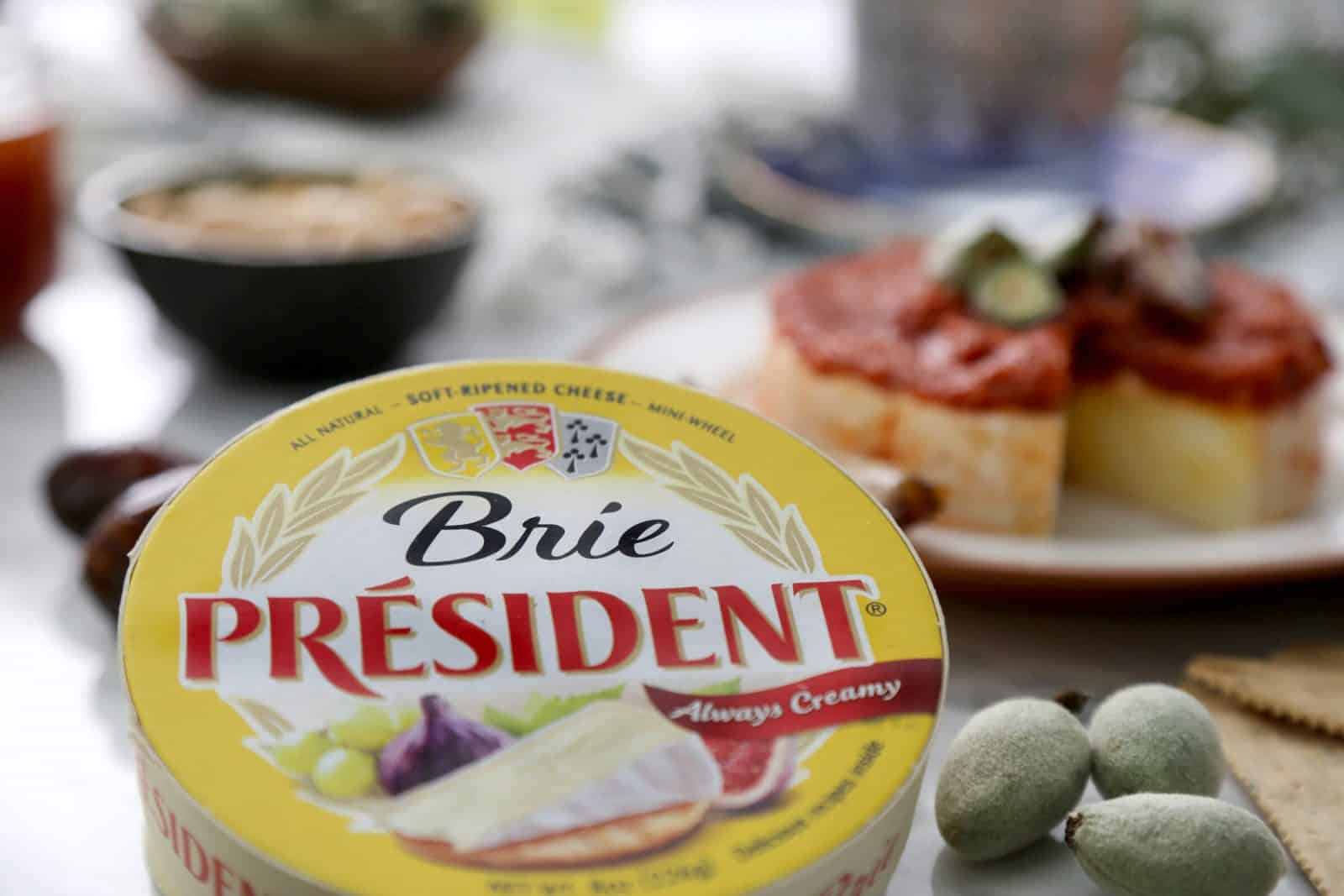
Camembert cheese and Brie are two of the most beloved and well-known French cheeses. Originating from different regions in France, these creamy delights have become synonymous with indulgence and sophistication. While they may appear similar at a glance, Camembert and Brie each possess their own distinct characteristics in terms of texture, flavor profile, and production process. In this article, we will explore the similarities and differences between Camembert cheese and Brie, shedding light on what makes them unique and how they can be enjoyed in various culinary creations.
History And Origin Of Camembert Cheese And Brie
Camembert cheese and Brie have rich histories and distinct origins. Camembert cheese originated in the late 18th century in the village of Camembert in Normandy, France. It was created by a farmer named Marie Harel, who adopted a recipe for soft cheese from a priest. On the other hand, Brie cheese has been produced since the 8th century in the Brie region of France, located east of Paris. It is believed to have been enjoyed by both Charlemagne and King Louis XVI. Both cheeses have since gained international recognition and are treasured for their unique flavors and textures.
Similarities And Differences Between Camembert Cheese And Brie
Camembert cheese and Brie have several similarities, but they also have distinct differences. Both cheeses are soft-ripened and have a creamy texture. They are made from cow’s milk and have a bloomy rind. However, there are some differences in flavor and aroma. Camembert has a stronger, earthier flavor with notes of mushroom and garlic, while Brie has a milder, buttery flavor with hints of sweetness and nuttiness. Additionally, Camembert has a slightly more pungent taste due to its fermentation process. Overall, while these cheeses share some characteristics, they offer unique taste experiences.
Texture And Appearance
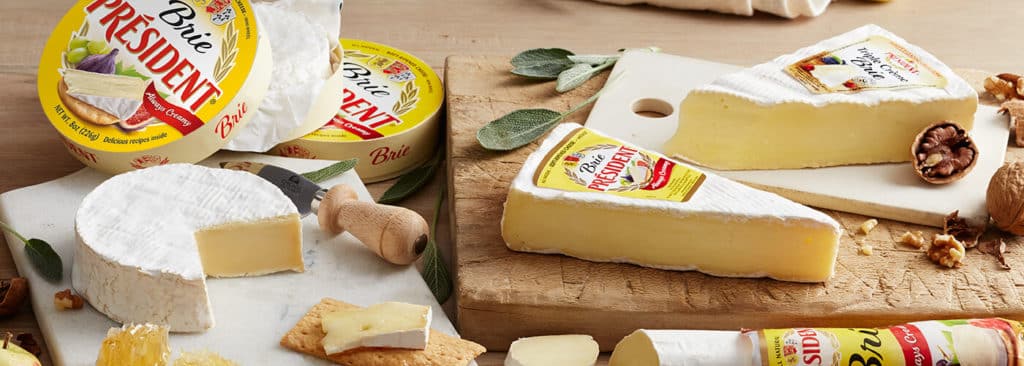
When it comes to the texture and appearance of Camembert cheese and Brie, there are some distinct differences. Camembert cheese tends to be denser and has a firmer texture compared to Brie. It cuts into a smooth and velvety paste that holds its shape. On the other hand, Brie has a creamier texture, thanks to its higher fat content, and it has a tendency to spread and melt at room temperature. In terms of appearance, both cheeses have a bloomy rind, but Camembert often has a slightly thicker and more rustic-looking rind.
Texture And Mouthfeel Of Camembert Cheese
The texture of Camembert cheese can be described as dense and firm, yet still maintaining a creamy and smooth consistency. When cut, it reveals a rich and velvety interior that has a slightly denser feel compared to Brie. The mouthfeel of Camembert is smooth and supple, with a satisfying creaminess that coats the palate. The rind of Camembert adds an extra layer of flavor and texture, providing a delicate and edible contrast to the soft interior. Overall, Camembert cheese offers a luxurious and indulgent texture and mouthfeel.
Texture And Mouthfeel Of Brie Cheese
The texture of Brie cheese is famously soft and creamy, often described as velvety or melt-in-your-mouth. It has a smooth and buttery consistency that is spreadable when served at room temperature. Brie cheese has a rich and luxurious mouthfeel, with a luscious and indulgent creaminess that coats the palate. When properly ripened, the interior of Brie becomes oozy and slightly runny, adding to its luxurious texture. The rind of Brie cheese is edible but has a slightly firmer and chewier texture compared to the soft interior. Overall, Brie cheese provides a satisfying and sumptuous texture and mouthfeel.
Flavor Profile
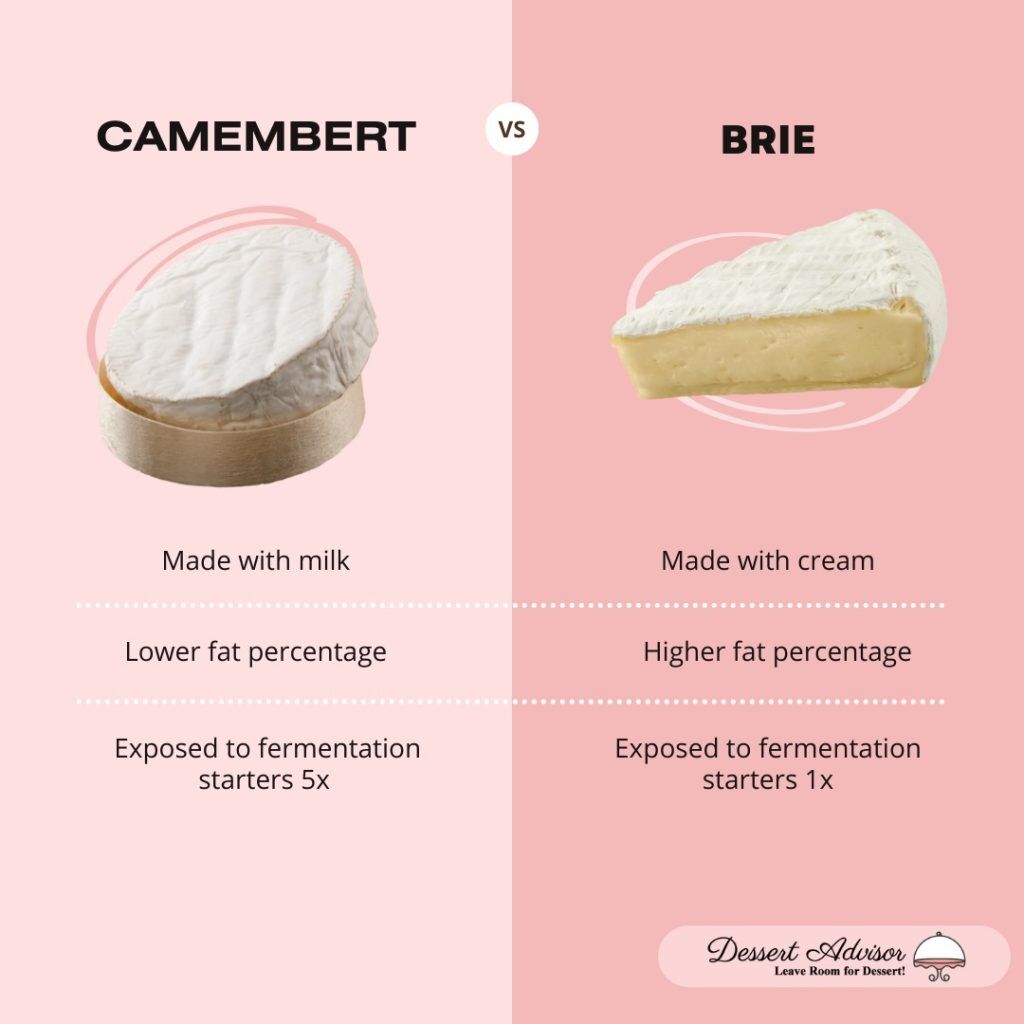
The flavor profile of Camembert cheese is often described as earthy, creamy, and mushroom-like. It has a distinct aroma that is reminiscent of mushrooms and damp earth, which intensifies as the cheese ripens. The taste of Camembert is rich and buttery, with a hint of saltiness and a tangy edge. It has a slightly acidic and complex flavor that develops over time. Brie cheese, on the other hand, has a milder flavor compared to Camembert. It is buttery, slightly sweet, and has subtle hints of nuts and mushrooms. Brie cheese has a more delicate flavor that pairs well with a variety of accompaniments.
Flavor Characteristics Of Camembert Cheese
Camembert cheese is known for its rich and complex flavor profile. The cheese has a distinct earthy and mushroom-like aroma that intensifies as it ripens. Its taste is creamy and buttery, with a slight tanginess and a hint of saltiness. Camembert also has a slightly acidic undertone that adds to its depth of flavor. As the cheese ages, its flavor becomes more robust and pungent. These flavor characteristics make Camembert a favorite among cheese lovers who appreciate its unique and intense taste.
Flavor Characteristics Of Brie Cheese
Brie cheese is known for its mild and creamy flavor. It has a delicate and buttery taste that is often described as nutty and slightly sweet. The cheese has a subtle tanginess that adds to its overall complexity. As Brie cheese ages, its flavor becomes more pronounced and develops a hint of mushroom undertones. The rich and smooth texture of Brie melts in the mouth, making it a delight to savor. Its versatile flavor profile makes it a perfect accompaniment to fruits, crackers, and even desserts.
Production Process
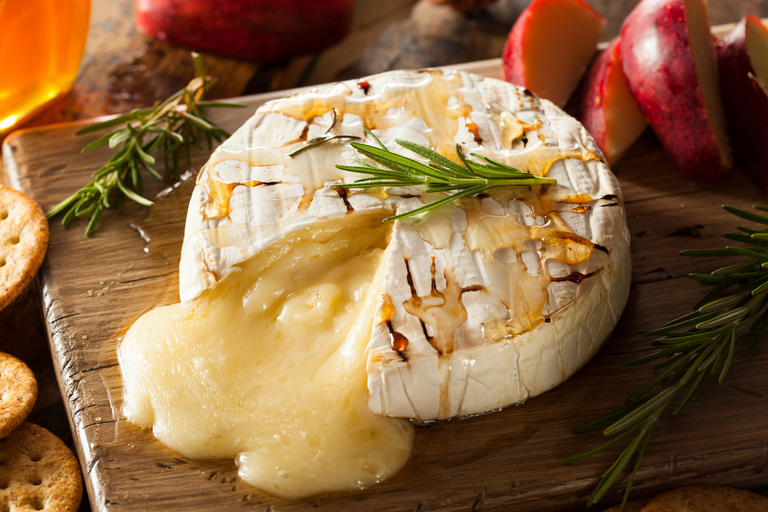
The production process of Camembert cheese and Brie cheese shares many similarities, as they are both made from cow’s milk using traditional methods. However, there are a few key differences that result in distinct flavors and textures. Camembert cheese utilizes stronger lactic starters, which are used more frequently throughout the cheese-making process, giving it a more robust flavor and aroma. On the other hand, Brie cheese incorporates cream into its recipe, making it higher in fat and contributing to its rich and creamy texture. These variations in production techniques contribute to the unique characteristics of each cheese.
Traditional Methods Of Making Camembert Cheese
Camembert cheese is made using traditional methods that have been passed down through generations. The process begins by collecting fresh cow’s milk and allowing it to sit and naturally separate into curds and whey. The curds are then cut into small pieces and gently stirred before being placed into molds. The cheese is then left to ripen for several weeks in a cool and humid environment. During this time, the cheese develops its characteristic bloomy rind and creamy texture. Finally, the cheese is carefully packaged and ready to be enjoyed. This traditional method ensures the distinct flavor and texture that Camembert cheese is known for.
Traditional Methods Of Making Brie Cheese
Brie cheese is made using similar traditional methods as Camembert cheese. The process begins by collecting fresh cow’s milk and allowing it to naturally separate into curds and whey. The curds are then cut into small pieces and gently stirred before being placed into molds. The cheese is then left to ripen for several weeks in a cool and humid environment. During this time, the cheese develops its characteristic bloomy rind and smooth, creamy texture. Finally, the cheese is carefully packaged and ready to be enjoyed.
Serving And Pairing
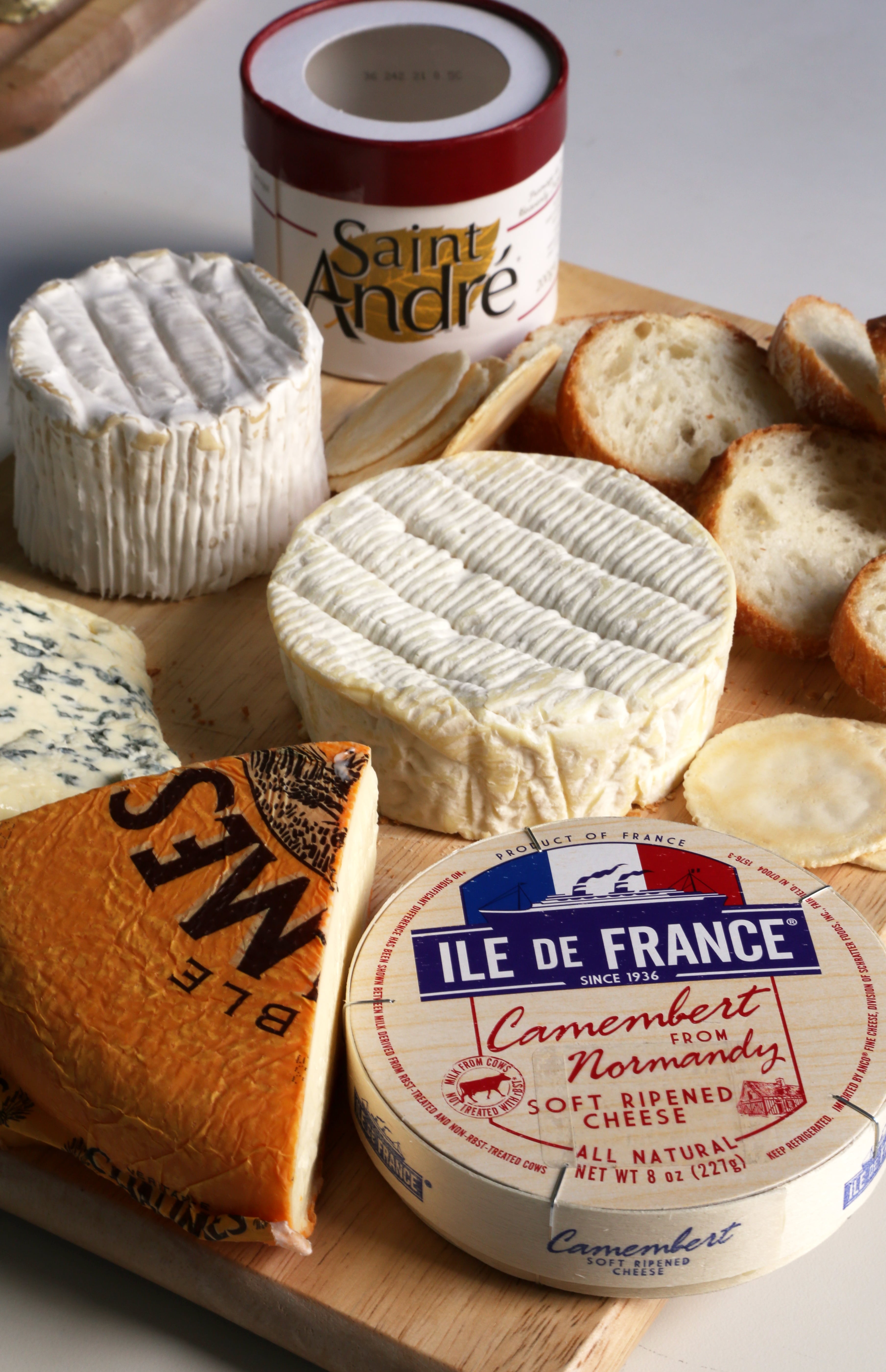
When it comes to serving and pairing Camembert cheese, there are a few recommendations to enhance its flavors. Serve the cheese at room temperature to bring out its creamy texture and delicate taste. Accompany it with a crusty baguette or French bread, as well as some fresh fruits like apples or grapes. The mild and buttery flavor of Camembert pairs well with a crisp white wine or a light-bodied red wine, such as Chardonnay or Pinot Noir.
As for Brie cheese, it is also best served at room temperature. Pair it with a variety of accompaniments, such as crackers, sliced baguette, or even toasted nuts. Brie’s creamy and rich flavor complements a range of flavors, making it a versatile cheese for pairing. It pairs well with both white and red wines, depending on personal preference. Some popular choices include Champagne, Sauvignon Blanc, or Merlot.
It’s important to note that serving and pairing suggestions can vary based on personal preference and regional culinary traditions. Ultimately, the aim is to find complementary flavors and textures that will enhance the experience of enjoying these delightful cheeses.
Serving Suggestions For Camembert Cheese
Camembert cheese is best enjoyed at room temperature to bring out its creamy texture and delicate taste. To enhance the flavors of Camembert, serve it with a crusty baguette or French bread, which provides a perfect canvas for spreading the cheese. For a touch of sweetness, pair Camembert with fresh fruits like apples or grapes. To round out the experience, consider offering some artisanal crackers or toasted nuts for added texture. When it comes to drinks, the mild and buttery flavor of Camembert pairs well with a crisp white wine or a light-bodied red wine, such as Chardonnay or Pinot Noir.
Serving Suggestions For Brie Cheese
When it comes to serving Brie cheese, there are several delicious options to consider. Here are some serving suggestions for Brie:
- Baguette and Crackers: Like Camembert, Brie goes well with slices of crusty baguette or a selection of artisanal crackers.
- Fresh Fruits: Pair Brie with fruits like sliced apples or grapes for a touch of sweetness and added freshness.
- Nuts and Honey: For a delightful combination of flavors, serve Brie with toasted nuts and a drizzle of honey.
- Charcuterie Board: Include Brie as a centerpiece on a charcuterie board along with cured meats, olives, and other cheeses.
- Wine Pairing: Brie pairs beautifully with a variety of wines, such as Champagne, Pinot Noir, or Sauvignon Blanc.
By considering these serving suggestions, you can create a memorable and enjoyable Brie cheese tasting experience.
Conclusion
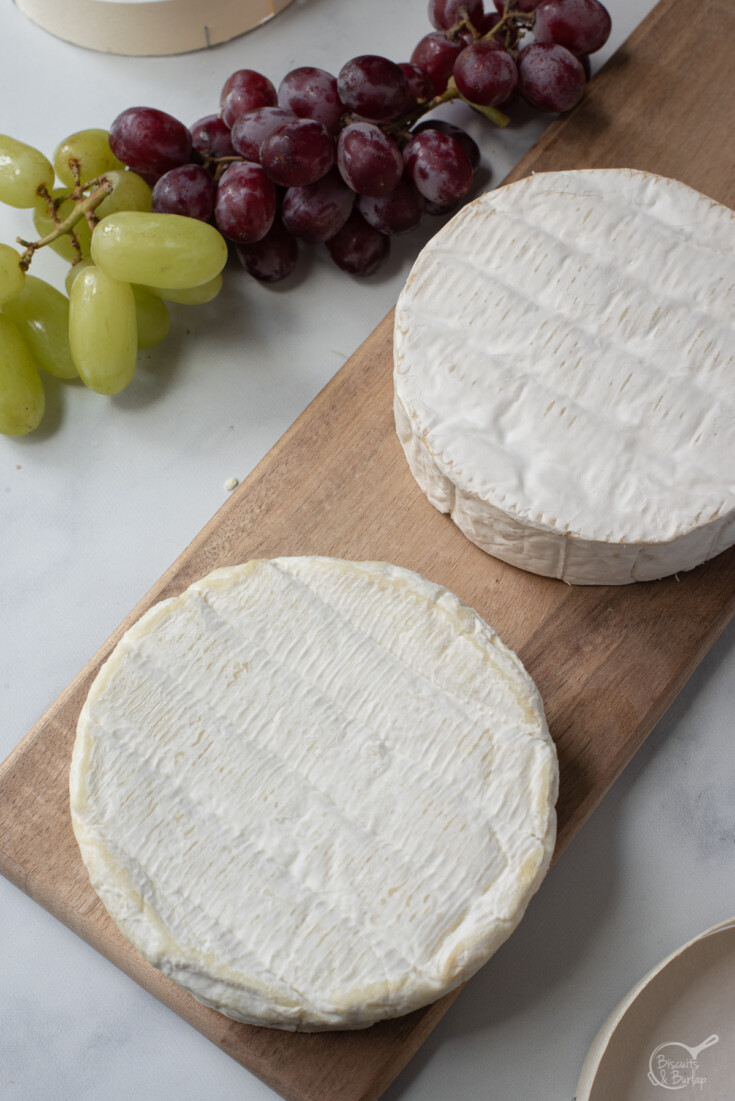
In conclusion, understanding the differences between Camembert cheese and Brie is crucial for cheese enthusiasts and culinary explorers. While these two iconic French cheeses may appear similar, they each possess unique characteristics that set them apart. By delving into their history, production processes, flavors, and culinary uses, we gain a deeper appreciation for the artistry and craftsmanship behind each cheese. Whether it’s the slightly firmer texture of Camembert or the creamy and smooth consistency of Brie, both cheeses offer a delightful experience for cheese lovers around the world.
Final Thoughts On The Differences And Similarities Between Camembert Cheese And Brie
Camembert cheese and Brie may share commonalities as soft-ripened French cheeses with creamy textures, but they each have distinct characteristics that differentiate them. Camembert tends to be denser and have a stronger flavor, while Brie offers a milder and buttery taste. Both cheeses are exceptional in their own right and can bring a unique taste experience to any dish. Whether indulging in the rich and earthy flavors of Camembert or the delicate and luscious essence of Brie, cheese enthusiasts can savor the complexities and nuances of these two delightful creamy delights.
Popular Recipes Using Camembert Cheese And Brie Cheese
There are numerous delicious recipes that incorporate Camembert cheese and Brie cheese. Here are a few popular options:
- Baked Camembert: A classic and simple dish where the Camembert cheese is baked until it becomes gooey and creamy. It is often served with crusty bread, crackers, or fresh fruits.
- Brie and Apple Grilled Cheese: This twist on a traditional grilled cheese sandwich combines the creaminess of Brie cheese with the sweetness of thinly sliced apples. It is grilled to perfection until the cheese melts and the flavors meld together.
- Camembert and Cranberry Tart: A delightful combination of sweet and savory, this tart features a flaky crust filled with melted Camembert cheese and tangy cranberry sauce.
These recipes showcase the versatility and delectable flavors of both Camembert and Brie cheese. Whether enjoyed on their own or incorporated into creative dishes, these cheeses are sure to impress any cheese lover.
Frequently Asked Questions about Camembert Cheese vs Brie
1. What is the difference between Camembert cheese and Brie?
Camembert and Brie are both soft, creamy, and mildly aromatic French cheeses. The main difference lies in their texture, flavor profile, and production methods. Camembert has a denser texture with a stronger flavor, while Brie is slightly creamier with a milder taste.
2. How are Camembert and Brie made?
Both cheeses are made from cow’s milk and undergo a similar process of production. The key difference lies in the inoculation process. Camembert is traditionally made with a specific fungal culture called Penicillium camemberti, while Brie is made with Penicillium candidum. Additionally, Camembert is ripened for a shorter duration compared to Brie.
3. Do Camembert and Brie have different rinds?
Yes, the rinds of Camembert and Brie exhibit some variation. Camembert’s rind is usually white, fluffy, and edible, while the rind of Brie is typically lighter in color, smoother, and also edible. The rinds contribute to the distinct flavors and aromas of each cheese.
4. Can Camembert and Brie be used interchangeably in recipes?
While Camembert and Brie share many similarities, they do have distinct characteristics that may affect the overall taste of a recipe. Consequently, it is recommended to use the cheese specified in a recipe to achieve the intended flavor profile. However, they can usually be used as substitutes for each other in most recipes without major issues.
5. Can Camembert and Brie be stored in the same way?
Both Camembert and Brie are generally stored in a similar manner. They should be refrigerated and kept in their original packaging until ready to be consumed. To maintain their freshness, it is advised to consume them within a few days after opening. However, it’s worth noting that Camembert tends to ripen slightly faster than Brie.
6. Are there any notable regional differences in the production of Camembert and Brie?
Yes, there are regional differences in the production of Camembert and Brie. Traditionally, Camembert is produced in Normandy, France, while Brie is produced in the Ile-de-France region. These regional variations can influence the terroir and flavor nuances of each cheese.
7. How should Camembert and Brie be served?
Both Camembert and Brie can be served at room temperature to enhance their flavors and aromas. They are commonly enjoyed spread over crackers or bread, added to cheese platters, or used as versatile ingredients in various recipes like sandwiches, quiches, or salads.
In summary, while Camembert and Brie share many similarities, they differ in terms of texture, flavor intensity, rinds, ripening duration, and regional production. Understanding these distinctions can help you appreciate both cheeses for their unique qualities and enjoy them in different culinary applications.

Kemah Cafe is a family-owned eatery that takes pride in offering a delightful array of Vietnamese, Chinese, and Thai dishes. Located at the heart of the community, Kemah Cafe has been serving up delicious Pho and other authentic Asian cuisine for many years. Founded with a passion for sharing the flavors of the East, Kemah Cafe has become a beloved culinary destination for locals and visitors alike. The warm and welcoming atmosphere of the cafe, combined with the tantalizing aromas of freshly prepared dishes, creates an unforgettable dining experience.